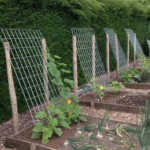Are you struggling to find the perfect spot for your vegetable garden because of limited sunlight in your yard? Don’t worry, you’re not alone. Many aspiring gardeners face the challenge of finding suitable areas to grow their favorite vegetables. This article will explore the benefits of growing a vegetable garden in the shade, as well as provide valuable tips and advice for maximizing productivity in shaded areas.
Shade gardens offer unique advantages for growing vegetables, from providing protection against harsh sunlight to creating a cooler environment for certain crops. In this section, we will delve into the various benefits of choosing a shaded area for your vegetable garden and how it can contribute to the overall success of your gardening endeavors.
Whether you’re a seasoned gardener or just starting out, selecting the right vegetables for shade gardens is crucial for ensuring a bountiful harvest. We’ll discuss which types of vegetables thrive in low-light conditions and how to optimize your plant selection for maximum yield. Understanding the specific needs of shade-tolerant plants is essential for a successful shaded vegetable garden, and we’ll provide valuable insights to help you make informed choices.
Choosing the Right Vegetables for Shade Gardens
When it comes to growing a vegetable garden in the shade, it’s essential to choose the right vegetables that thrive in low-light conditions. While many traditional vegetable garden crops require full sun, there are still plenty of options for those with shady yards or limited sunlight. By selecting the appropriate vegetables for your shade garden, you can still enjoy a bountiful harvest without the need for a sunny plot.
Here are some vegetables that are well-suited for shade gardens:
- Leafy Greens: Spinach, lettuce, kale, and Swiss chard are all excellent choices for shady areas. These vegetables actually prefer cooler temperatures and can tolerate less sunlight than other crops.
- Root Vegetables: Some root crops like beets and carrots can flourish in partial shade. While they may not grow as quickly as those in full sun, they can still produce a decent crop when given adequate care.
- Herbs: Herbs such as mint, parsley, and cilantro can do well in shaded conditions. In fact, too much direct sun can cause these herbs to bolt or become bitter, making them ideal candidates for a shaded garden.
It’s important to note that while these vegetables may tolerate shade better than others, they still require some sunlight to grow and produce a good harvest. When planting a shade vegetable garden, consider the amount of light your specific location receives and select vegetables accordingly.
In addition to choosing the right vegetables for your shade garden, it’s also crucial to pay attention to soil quality and watering practices. With proper care and consideration, you can create a thriving vegetable garden even in the shadiest of spots.
Understanding the Importance of Soil and Watering in Shade Gardens
When it comes to growing a vegetable garden in the shade, understanding the importance of soil and watering is crucial for success. While sunlight may be limited in shaded areas, the right soil conditions and proper watering techniques can help ensure healthy and thriving plants.
Soil Composition for Shade Gardens
In shady areas, it’s important to pay attention to the composition of the soil. Opt for well-draining soil that retains moisture, as shaded areas tend to have less evaporation compared to sunny spots. Adding organic matter such as compost or peat moss can improve the soil’s structure and nutrient content, providing a solid foundation for your shade-loving vegetables.
Watering Strategies for Shade Gardens
Proper watering is essential for vegetable gardens in shaded areas. Since these spots receive less direct sunlight, they require less water compared to sunnier locations. Overwatering can lead to soggy soil and root rot. It’s best to water deeply but less frequently to encourage deep root growth and prevent waterlogged conditions. Consider using mulch around your plants to help retain moisture and regulate soil temperature in shaded areas.
Fertilizing Considerations
In shade gardens, it’s important to monitor the nutrient levels in the soil since plants may not receive as much sunlight for photosynthesis. Regularly fertilize your vegetable garden with a balanced fertilizer to provide essential nutrients that might be lacking due to reduced sunlight exposure. A slow-release fertilizer applied according to package directions can help ensure that your shade-loving vegetables have access to the nutrients they need for optimal growth.
By understanding how soil composition, watering strategies, and fertilizing considerations play vital roles in shade gardens, you can create an environment where your vegetables can thrive despite limited sunlight exposure.
Tips for Maximizing Sunlight in Shady Vegetable Gardens
When it comes to shade vegetable gardens, maximizing sunlight is crucial in ensuring the successful growth of your plants. While shade gardens may not receive as much direct sunlight as their sunny counterparts, there are still ways to optimize the light that reaches your vegetable crops. Here are some tips for getting the most out of the sunlight in your shady vegetable garden:
- Place reflective surfaces strategically: Consider positioning light-colored stones or reflective mulch around your plants to help bounce sunlight onto their leaves.
- Prune nearby trees and shrubs: Trimming overhead branches can allow more light to filter through to your garden.
- Utilize vertical gardening techniques: Growing vining vegetables like cucumbers or pole beans on trellises can help them reach for available sunlight and maximize space.
By implementing these strategies, you can make the most of the natural light in your shade garden and promote healthy growth for your vegetable crops.
In addition to these techniques, consider incorporating artificial lighting in your shade vegetable garden. LED grow lights can be used to supplement natural sunlight, especially during periods of limited daylight or prolonged cloudy weather. Positioning these lights at various heights and angles can help ensure that all areas of your garden receive adequate illumination.
Expert Tip
“Stay mindful of plant placement in a shade garden. By regularly observing how the sun moves across your garden throughout the day, you can adjust the positioning of your plants to make sure they receive optimal sunlight,” advises experienced shade gardener, Karen Smith.
Dealing With Common Pests and Diseases in Shade Gardens
Identifying Common Pests and Diseases
When it comes to maintaining a healthy vegetable garden in the shade, it’s important to be vigilant about pests and diseases that thrive in low-light conditions. Some common pests to watch out for in shade gardens include slugs, snails, aphids, and spider mites. These insects can quickly damage your plants if not properly controlled. Additionally, certain diseases such as powdery mildew and fungal infections are more likely to occur in shaded areas due to higher humidity levels.
Natural Pest and Disease Management
One effective way to manage pests and diseases in shade gardens is by using natural methods rather than chemical pesticides. For example, introducing beneficial insects like ladybugs or lacewings can help control aphid populations. Additionally, regularly inspecting your plants for any signs of disease or infestation can help catch problems early before they become widespread. Proper sanitation practices such as removing diseased plant material can also prevent the spread of diseases.
Implementing Preventative Measures
Preventing pests and diseases from taking hold in your shade garden is essential for maintaining a successful harvest. One preventative measure is to space your plants appropriately to allow for good air circulation, which can help reduce the risk of fungal infections. Furthermore, practicing crop rotation from year to year can help minimize the build-up of soil-borne diseases. Finally, keeping your vegetable garden well-nourished with organic fertilizers can strengthen plant resistance to pests and diseases.
By being proactive and implementing these strategies, you can effectively manage common pests and diseases in your shade vegetable garden while promoting the health of your plants and maximizing their productivity.
Creative Container Gardening Ideas for Shaded Areas
When it comes to vegetable gardens and shade, one way to make the most of limited sunlight is through creative container gardening. Container gardening allows you to move your plants around to find the best spots for sun exposure throughout the day. Additionally, it enables you to add visual interest to shaded areas with various types of containers and plants.
One of the key benefits of container gardening in shaded areas is the ability to control the soil that your vegetables are growing in. This is particularly important in shady spots where the soil may not have as much nutrients as sun-drenched areas. You can choose a high-quality potting mix specifically designed for vegetables, ensuring that your plants get the nutrients they need even in a less than ideal growing environment.
Another advantage of container gardening in shaded areas is the opportunity to add vertical elements. Since sunlight may be scarce on the ground level, you can use trellises or stakes to grow climbing vegetables such as peas, cucumbers, or pole beans. These vegetables can make great use of what little sunlight they receive and also add height and structure to your shade garden.
It’s also worth considering companion planting in containers in shaded areas. Some vegetables actually thrive in each other’s company and planting them together can help maximize limited sunlight and reduce the risk of pests and diseases spreading. For example, planting shade-tolerant herbs like cilantro or mint alongside your leafy greens can enhance their growth while also adding fragrance and flavor to your container garden.
| Benefit of Container Gardening | Example |
|---|---|
| Portable – allows for moving plants for better sun exposure | Moving potted tomatoes from morning sun into afternoon sun |
| Control over soil quality | Using a high-quality potting mix with added compost for nutrients |
| Opportunity for vertical gardening by using stakes or trellises | Growing pole beans on a trellis in a shaded area |
Success Stories
Vegetable gardens can be successfully grown in shady areas, and many gardeners have shared inspiring success stories of their thriving shade vegetable gardens. Despite the challenges of limited sunlight, these gardeners have managed to overcome obstacles and produce an abundant harvest. These success stories serve as motivation for other gardeners who may be hesitant to start a vegetable garden in shady locations.
One such success story comes from Sarah, who transformed a previously neglected shaded area in her backyard into a flourishing vegetable garden. By carefully selecting the right vegetables for shade and implementing creative container gardening ideas, Sarah was able to make the most of the limited sunlight.
She also used reflective surfaces and strategically placed mirrors to maximize the natural light that reached her vegetable plants. Through dedication and perseverance, Sarah’s shade vegetable garden became a source of pride and joy, proving that with the right approach, even shady areas can yield bountiful harvests.
Another inspiring example is from John, an experienced gardener who experimented with different techniques to combat common pests and diseases in his shade vegetable garden. John’s innovative methods not only protected his plants but also led to higher yields than expected.
His willingness to adapt and learn from challenges resulted in a successful and productive shade vegetable garden. These success stories demonstrate that with proper planning, knowledge, and creativity, it is possible to achieve remarkable results in shade vegetable gardens.
| Success Story | Key Takeaway |
|---|---|
| Sarah’s Backyard Garden | Utilizing reflective surfaces and containers for successful shade gardening. |
| John’s Pest Control Experiment | Innovative pest control methods leading to higher yields in shaded areas. |
Expert Advice
Shade gardening can present some unique challenges, but with the right tips and tricks, you can still have a successful vegetable garden. Experienced shade gardeners have learned through trial and error how to maximize the potential of their shaded areas, and their advice can be invaluable for those new to this type of gardening.
One important tip from experienced shade gardeners is to choose vegetables that are particularly well-suited for low light conditions. Leafy greens like lettuce, spinach, and kale are excellent choices for shade gardens, as they require less direct sunlight than fruiting vegetables like tomatoes or peppers. Additionally, root vegetables such as carrots and beets can also thrive in shady areas.
Another piece of expert advice is to pay close attention to soil quality and watering practices in shade gardens. Amending the soil with organic matter like compost can improve its ability to retain moisture, which is crucial for plants in low light conditions. Additionally, using mulch around plants can help regulate soil temperature and moisture levels. Watering schedules should also be adjusted for shaded areas, as they may require less frequent watering compared to plants in full sun.
Experienced shade gardeners also emphasize the importance of maximizing any available sunlight in shaded vegetable gardens. This can be achieved by strategically placing containers or raised beds in sunnier spots within the shaded area. Furthermore, choosing lighter colored containers or reflective materials can help bounce sunlight towards the plants. With these tips and tricks from seasoned shade gardeners, anyone can create a thriving vegetable garden even in shady conditions.
Conclusion
In conclusion, embracing the beauty and productivity of shade vegetable gardens offers a unique and rewarding gardening experience. While many may think that shade is a hindrance to growing vegetables, it actually provides several benefits such as cooler temperatures for delicate plants and protection from scorching heat.
Choosing the right vegetables for shade gardens is essential, as well as understanding the importance of soil quality and proper watering. With some creativity and thoughtful planning, shady areas can be transformed into flourishing vegetable gardens.
One important factor to consider when creating a shade vegetable garden is maximizing sunlight exposure. This can be achieved through strategic placement of containers or raised beds, as well as pruning nearby trees or shrubs to allow more light to reach the plants. Additionally, staying vigilant against common pests and diseases is crucial in maintaining the health of shade vegetables. By taking proactive measures and staying informed about potential threats, gardeners can effectively manage these challenges.
Finally, seeking advice from experienced shade gardeners and learning from their success stories can provide valuable insights and inspiration. Their tips and tricks, combined with careful planning and dedication, can help anyone create a thriving vegetable garden in shaded areas.
With a bit of effort and creativity, gardening in the shade can result in bountiful harvests and visually stunning landscapes. Embracing the beauty of shade vegetable gardens opens up new possibilities for gardeners to enjoy the wonders of nature while cultivating their own fresh produce.
Frequently Asked Questions
Can a Vegetable Garden Be in Shade?
A vegetable garden can be in shade, but it’s important to choose the right vegetables that thrive in low light conditions. While most vegetables do best in full sun, there are some that can still produce a good harvest in partial shade.
What Vegetables Are Good to Grow in the Shade?
Some vegetables that are good to grow in the shade include leafy greens like spinach, lettuce, and kale. Root vegetables like carrots and beets can also tolerate some shade. Herbs such as mint, parsley, and cilantro can also do well with less sunlight.
What Is the Minimum Sunlight for a Vegetable Garden?
The minimum sunlight for a vegetable garden is around 4-6 hours of direct sunlight per day. This amount of sunlight will allow most vegetables to grow and produce a decent harvest. However, it’s important to consider the specific sunlight requirements of each vegetable when planning your garden layout.

If you’re looking to get into vegetable gardening, or are just looking for some tips on how to make your current garden better, then you’ve come to the right place! My name is Ethel and I have been gardening for years. In this blog, I’m going to share with you some of my best tips on how to create a successful vegetable garden.





